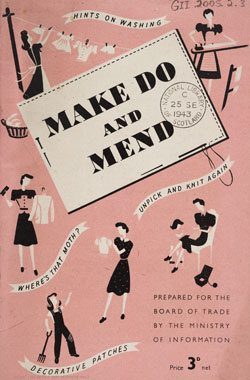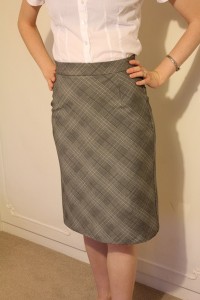One trend I’ve noticed in recent years is that of ‘refashioning’ clothes (or ‘restyling’). This is different from simply altering clothes which don’t fit, but usually involves making some significant style changes to the garment as well. If you start looking online, you’ll find dozens of blogs chronicling the transformation of old tops, sweaters and dresses from people’s closets, as well as the purposeful efforts of others to buy secondhand clothes and update them into stylish ‘new’ clothes. Casey at Elegant Musings has some wonderful examples of this.
I’ve done quite a bit of this myself, but often with mixed success. I remember an old baby-blue t-shirt of my dad’s which I ambitiously refashioned in my teens – I recut the neckline, took in the side seams and shortened it, and changed the sleeves. I cut the neckline crooked and then tacked some white ribbon around it. It makes me laugh and/or cringe to think of now, but I wore it a lot for a short period! More recently, I’ve done a little bit of refashioning since moving to the UK, primarily because I now rely on charity shops so much for clothes. One more successful attempt was my bridesmaid dress for my sister’s wedding, which I shortened and then used the extra fabric to add the halter strap.
What’s interesting to me about the whole refashioning trend is that it’s intensely retro. As far as I know, the most recent spate of refashioning probably occurred during World War II, when the British government published pamphlets with instructions for how to use old clothes to make new ones, either by altering the style to hide damage and wear, or by using pieces of old garments to make new ones, like cutting down men’s shirts to make women’s blouses. I read this series of pamphlets recently, and many of the projects recommended were very like the ones I’ve seen undertaken on refashioned garments. The ‘make do and mend’ incentive was, of course, motivated by genuine shortages. Rationing of clothing meant that an average adult would only get the equivalent of one complete new outfit per year – which, when I think about the amount of clothes I buy in a year, isn’t much.
 Ministry of information leaflet from 1943
Ministry of information leaflet from 1943
The recent refashioning trend isn’t motivated by actual shortages so much as by (I think) the collusion of a bad economy and increased environmental consciousness – making people doubly aware of how much they consume as well as the degree to which they can’t afford to do so.
I’ve been on a refashioning kick myself, lately. It started primarily because I finally have my sewing machine again, so I can be a little more ambitious in my projects. However, although sewing is economical generally, it isn’t always a cheap source of clothing. For £30 I can make a nicer skirt than I could probably buy for that amount, but that isn’t (to me!) a super-cheap source of clothes. It’s also hard to find fabric where we live. I know of a few sources, and there are always online sources, but the harder it is to find materials, most likely the more expensive they will be and the more pressure is on the project to turn out well. That got me wondering if refashioning might be the way forward – the best way to exercise my creative sewing juices, update my wardrobe a little, and do so at less expense and with less pressure. Charity shops abound in our area (there are 6 within about a 20-minute walk of us, and a 7th just opened), so in fact while fabric is hard to find, secondhand clothes are plentiful. It struck me that refashioning clothes is probably the best type of sewing for my position in life at the moment.
The only reason this wasn’t necessarily my first and most enthusiastic idea for sewing projects was that, in the past, not all of my refashioning projects have been very satisfactory, aside from a couple of successes. But, thinking about it, I realised that it wasn’t because of ineptitude on my part when it came to the sewing, but usually because I made poor decisions at the beginning, when shopping. I started out with the mindset that this was a cheap, quick project, and so didn’t merit much expense and in fact the quality of the clothing didn’t matter. I carried that attitude into the sewing, where, because the garment was cheap, I felt it wasn’t worth a great deal of time to alter properly, and so ended up with a poor-quality piece of clothing that was a bit sketchily reshaped.
I’ve decided to take a more purposeful approach to this.
First of all, when I visit charity shops I shop with an eye to fabric and colour first, rather than size or style. After doing some reading, I’ve realised that my labour is really only a worthwhile investment where the raw materials are worth my time, so I’ve started looking for natural fibres in colours and patterns I really like.
Second of all, I only buy something if I have a specific purpose for it and if, on a realistic assessment, I see how I could alter or refashion it. This is to avoid the ‘project graveyard’ of unwanted clothes malingering under my bed because I never got around to restyling them. And this criterion does rule out some projects. There was a beautiful cotton print dress I found recently which was a couple of sizes too big. I could have taken it apart and cut it down, but the seams were all flat felled and there were topstitched pleats, which are all a pain to remove and can’t be simply taken again with a quick seam but must be deconstructed entirely. I decided I didn’t want to tackle it, and so sadly left the dress behind. Someday perhaps I’ll have space to begin collecting items with ‘possibility’, but for now I insist that they have serious and immediate probability!
Thirdly, when it comes to the sewing, I do it right. I have so little time to sew that it always feels like I’m racing against the clock, so I’m always tempted to cut corners. I’ve just realised, over the years, that I usually regret my shabby, lazy sewing, and that if the garment is worth my time at all, it’s worth the time to put in a proper effort.
I’ll post about some of my projects when they’re finished. I have some plans and a few items I’m working on now. However, for now, I’ve just finished a very seriously refashioned skirt. This used to be an ankle-length A-line skirt that was a few sizes too big for me, but which I inherited from a friend when she moved away. In fact, I thought I had gotten rid of it when I moved recently, but I unearthed it in my sewing basket. Now, what I’m really proud of is that I decided to be ambitious and draft my own skirt pattern for this, using an online tutorial I found. I might still make a couple of small changes to my pattern, but it certainly does fit. (I’m not sure how keen I am on posting a picture of my hips online…but look at the skirt!)
Best of all, because I started with a skirt that already included lining and a zipper, the final cost came to nothing!

I applaud your efforts in this area! This is something that has crossed my mind, but I simply don’t have time to do myself. I’ve found it’s easier, faster, and more cost-effective for me to shop clearance racks, than to embark on a sewing project at this time in my life. I can take Kenna shopping, but she is way too curious, mischievous, and active for me to get into a serious project while she is awake. And currently, I try to use time she is asleep to clean, plan my grocery shopping trips, and catch up on correspondence (which obviously hasn’t gone so well over the past month!). I would love to be able to restyle clothes, though. Your skirt came out very well. I’d love to see how your other projects turn out!
My mom and I were talking about sewing recently, and agreed that while it isn’t a frivolous activity financially, it is ‘frivolous’ in terms of the time it takes. That’s fine for me right now, because I’ve got more time than money! I’m sure I’d prioritise differently in another circumstance. I think I also like the kind of unusual or quirky styles you end up with this way, and which you’d otherwise be paying a lot of money to have. (And I occasionally find a really high-quality item secondhand that I could never otherwise afford but which fits with just a little alteration.)
Wow, the skirt looks great. You did a wonderful job incorporating fabric and zip etc that you already had, made your own pattern and got a perfectly good skirt for free. You are right of course. With the right fabrics, and some care and thought, you can make really very good clothes that fit well and are of high quality for a lot less than the shop bought equivalent. Thanks for sharing the link to my pattern.